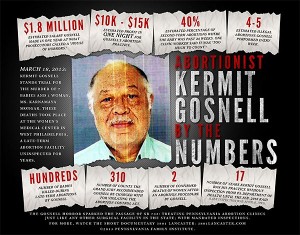Last updated on: April 12, 2013 at 8:59 am
By
mollie
I’ve been writing about media coverage of abortion for many years. And so have many others. If you haven’t read David Shaw’s “Abortion Bias Seeps Into The News,” published in the Los Angeles Times back in 1990, you should. That report also explains why we cover the topic here at GetReligion.
But the thing is that I’m getting kind of sick of pointing out egregious bias only to see things not just remain bad but get worse. Just think, in the last year, we saw the media drop any pretense of objectivity and bully the Susan G. Komen Foundation into funding Planned Parenthood. And then we had how many months of coverage focused on someone calling a birth control activist a bad name? And who can forget every pro-life person in the country being asked to respond to Todd Akin’s stupid remarks about rape?
So our abortion-drenched media would certainly want to cover what is arguably the country’s most horrific serial murder trial of abortion doctor Kermit Gosnell, right? Well, far from the front-page, top of the news, daily update coverage you rightfully would expect, it’s been downplayed. Majorly downplayed.
Inspired by Kirsten Powers’ USA Today column yesterday, I decided to start asking journalists about their personal involvement in the Gosnell cover-up.
I began by asking the AP’s national social issues reporter why he hadn’t been tweeting to AP coverage of the Gosnell trial. I had to ask a few times and then … there it was … finally …. a tweet on the Gosnell trial. Then he told me that the AP was covering the trial (which I knew, as I’ve critiqued it here). I reminded him that I was wondering why he hadn’t been tweeting to coverage of Gosnell. I asked him to correct me if I was wrong about his lack of tweets. He didn’t.
Then I decided, since tmatt has me reading the Washington Post every day, to look at how the paper’s health policy reporter was covering Gosnell. I have critiqued many of her stories on the Susan G. Komen Foundation (she wrote quite a bit about that) and the Sandra Fluke controversy (she wrote quite a bit about that) and the Todd Akin controversy (you know where this is going). In fact, a site search for that reporter — who is named Sarah Kliff — and stories Akin and Fluke and Komen — yields more than 80 hits. Guess how many stories she’s done on this abortionist’s mass murder trial.
Did you guess zero? You’d be right.
So I asked her about it. Here’s her response:
Hi Molly – I cover policy for the Washington Post, not local crime, hence why I wrote about all the policy issues you mention.
Yes. She really, really, really said that. As Robert VerBruggen dryly responded:
Makes sense. Similarly, national gun-policy people do not cover local crime in places like Aurora or Newtown.
So when a private foundation privately decides to stop giving money to the country’s largest abortion provider, that is somehow a policy issue deserving of three dozen breathless hits. When a yahoo political candidate says something stupid about rape, that is a policy issue of such import that we got another three dozen hits about it from this reporter. It was so important that journalists found it fitting to ask every pro-lifer in their path to discuss it. And when someone says something mean to a birth control activist, that’s good for months of puffy profiles.
But gosh darn it, can you think of any policy implications to this, uh, “local crime” story? And that’s all it is. Just like a bunch of other local stories the Washington Post also refuses to cover — local crimes such as the killing of Trayvon Martin and the killing of Matthew Shepard and the killing of students at an elementary school in Connecticut. Did the Washington Post even think of covering those local crime stories? No! Oh wait, they did? Like, all the time? Hmm. That’s weird. But did they cover them in terms of policy implications? Asking politicians for their views and such? Oh they did that, too? Hmm. So weird. Oh, and Sarah Kliff herself wrote one of those stories? Well, gosh, I’m so confused.
And what policies could possibly be under discussion with this Gosnell trial? Other than, you know, abortion clinic hiring practices? And enforcement of sanitary conditions? And laws on abortion practices that extend to killing live infants by beheading them? And the killing of their mothers? And state or federal oversight of clinics with records of botched abortions? And pain medication practices? And how to handle the racist practices of some clinics? And how big of a problem this is (don’t tell anyone but another clinic nearby to Gosnell was shut down this week over similar sanitation concerns)? And disposal of babies’ bodies? And discussion of whether it’s cool to snip baby’s spines after they’re born? And how often are abortion clinics inspected anyway? What are the results of inspections? When emergency rooms take in victims of botched abortions, do they report that? How did this clinic go 17 years without an inspection? Gosh, I just can’t think of a single health policy angle here. Can you?
I mean, God forbid we go big and actually discuss abortion policy in general — something Kliff is usually quite keen to do. (Here’s her 2010 piece for Newsweek headlined Remember Roe!)
Kliff is hearing from her readers now — mostly I know about this since literally hundreds of them are copying me on their responses. To put it quite mildly, they find her justification attempt stunning, disingenuous, callous, laughable and far, far worse. The most charitable response was this one from Billy Valentine:
(more…)














